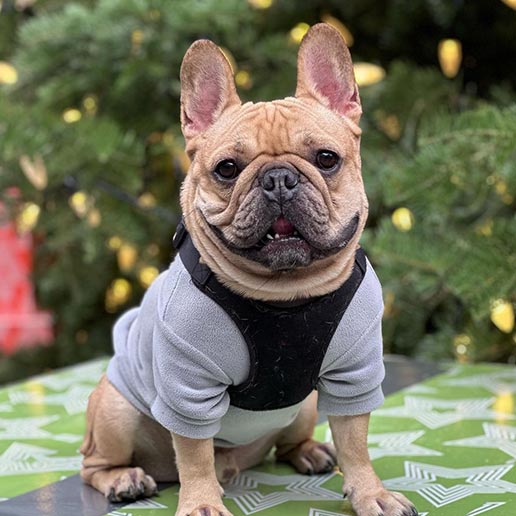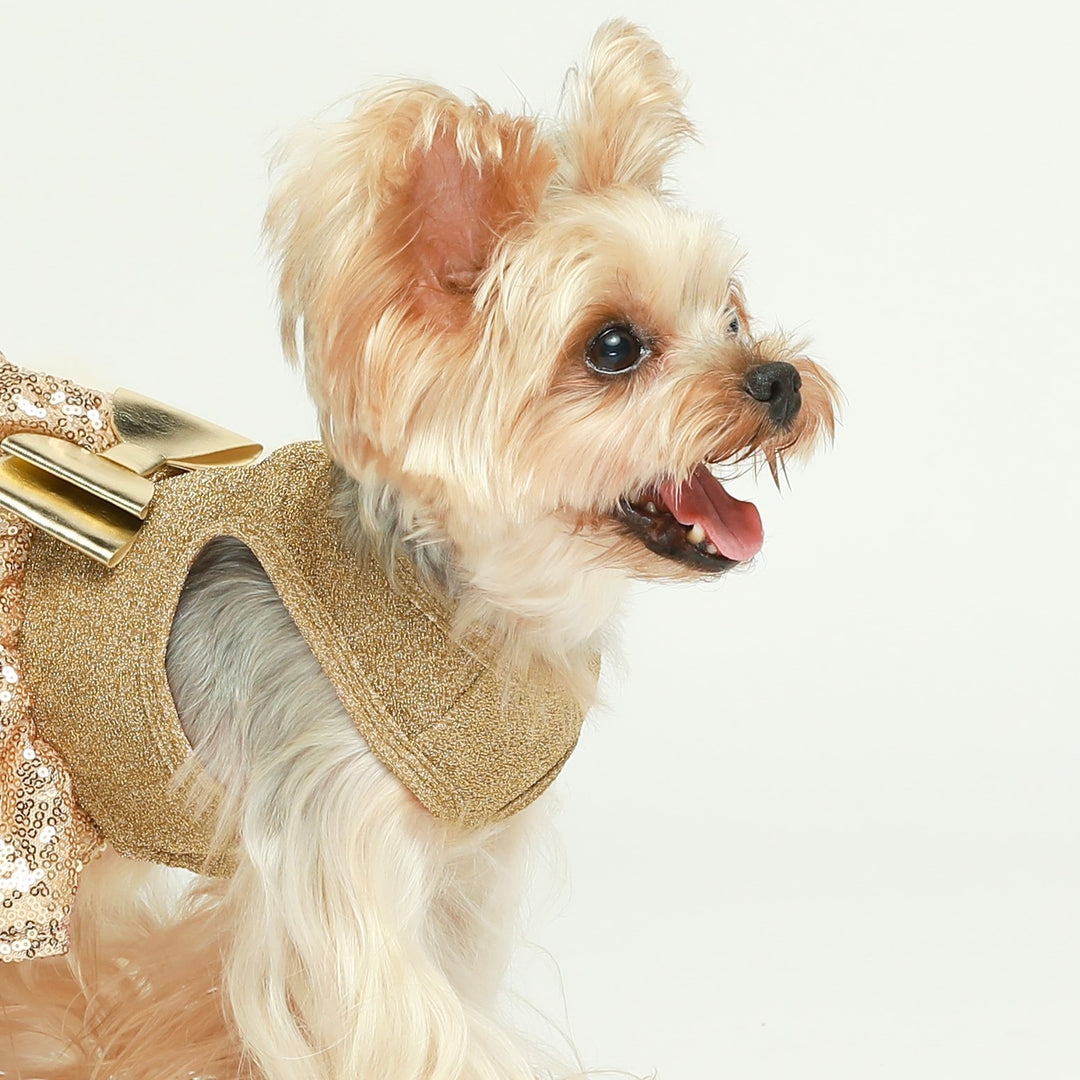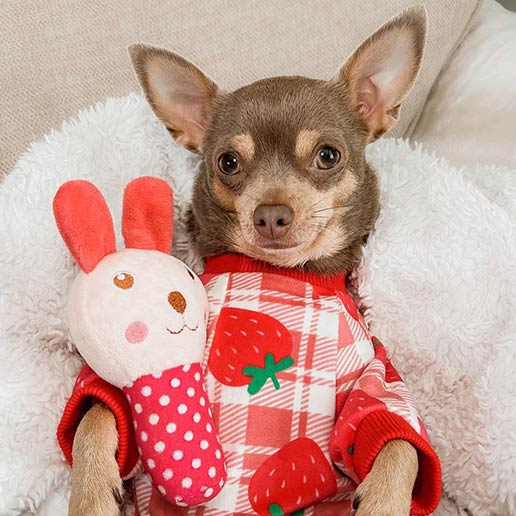Dog Sleep Positions Explained: What They Mean for Your Pet's Health and Mood
Have you seen your dog shaking a little while they sleep, or rolling up tight like a ball? How our dogs sleep can tell us a lot about how they're feeling. Each dog has its own way of sleeping that can show if they're relaxed or might have something bothering them. Different sleeping positions can mean different things. In this article, we'll look at the common ways dogs like to sleep and explain what these positions might mean for their health and happiness. This way, we can make sure our dogs aren't just sleeping well but are also feeling good when they're awake.
 Dachshund in a Waffle Striped Dog Pajamas
Dachshund in a Waffle Striped Dog Pajamas
| Sleeping Position | Description | Indications | Tips for Comfort |
| Lion's Pose | Dog sleeps with head on top of paws, alert but comfortable. | Light rest, readiness to move. | Quiet area, cozy bed with sides, favorite toy nearby. |
| Side Sleeper | Dog lies on their side with legs stretched out. | Relaxed, deep sleep, secure. | Soft, flat bed, large enough for stretching, orthopedic for older dogs. |
| Donut | Dog curls up in a ball, paws tucked in. | Preserves body heat, feels secure. | Round bed with raised edges, warm blanket, away from drafts. |
| Superman | Dog lies flat on their belly, legs stretched out. | Ready to play, cooling down. | Mat or bed with no edges, cooling mats in hot weather. |
| Belly-Up | Dog sleeps on their back with belly exposed and paws in the air. | Cooling off, very relaxed and secure. | Easy-access bed, cooling mat, shaded area. |
| Back-to-Back | Dog sleeps touching another dog or person. | Strong social bond, comfort. | Large enough bed for multiples, calming scents, consistent routine. |
| Burrower | Dog digs into bedding or burrows under blankets. | Seeking security and comfort. | Bed with blanket for burrowing, old clothes for scent, quiet spot. |
| On a Cold Surface | Dog chooses cool surfaces like tile floors. | To cool down, regulate body temp. | Cooling mats, elevated beds, ample water, shade outdoors. |
| Head and Neck Raised | Dog sleeps with head propped up. | May help breathing, alertness. | Bed with bolsters, good air quality, vet check if new behavior. |
| Cuddler | Dog sleeps in close contact with owner or animal. | Sign of strong bond, need for reassurance. | Own space rewards, separation practice, routine, mind-stimulating toys. |
 Instagram: apple_n_ari_2
Instagram: apple_n_ari_2The Lion's Pose
Sometimes dogs sleep with their head resting on top of their paws, much like a majestic lion. This position, often called "The Lion's Pose," can tell you that your dog is taking a light rest rather than being in a deep sleep. They're comfortable where they are but staying alert enough to pop up if they need to—maybe they want to keep an eye out for when you're heading to the kitchen for a snack!
This pose also suggests that while your dog feels safe, they're ready to protect themselves or their family if necessary. It's a common position for dogs who want to keep an eye on their surroundings.

To help your dog feel more secure in this position, make sure their sleeping area is in a quiet corner where they can see the room without being in the middle of foot traffic. A cozy bed with sides can add a sense of protection and give them something to lean against. Keep their favorite toy nearby, too, so they know they're in their special spot. Remember, the easier it is for your dog to relax, the more likely they'll drift off into a deeper sleep when they feel it's safe to do so.
The Side Sleeper
When dogs lie on their sides with their legs stretched out, it's called "The Side Sleeper" position. This is one of the most common ways dogs sleep, and it's a good sign—they're feeling pretty relaxed and secure in their environment. By exposing their belly, which is a vulnerable area, they're showing that they trust you and feel safe in their home.
This sleeping position also allows dogs to get more comfortable and move into a deeper sleep, where they can rest and recover from their busy day. It means they’re not worried about having to jump up quickly, so they can really unwind and enjoy their nap.
 Instagram: rescuingruthie
Instagram: rescuingruthieTo make your dog as comfy as possible in this position, a soft, flat bed works best. Look for one that's large enough for them to stretch out completely. Memory foam mats can be especially nice because they cushion your dog's joints, making it extra comfy for long snoozes. And if your dog is getting up there in years or has arthritis, orthopedic beds are great for providing that extra support their bodies need. Just make sure whatever bed you choose, it’s easy to clean because side sleepers often spend a lot of time lounging in dreamland!
The Donut or Curled-Up Position
Ever seen your dog curled up in a tight little ball, paws tucked in and tail wrapped around their body? This is the "Donut" or "Curled-Up" position, which is pretty adorable to see. Dogs do this for a couple of reasons—it helps them keep warm by preserving body heat and it's a natural way to protect their vital organs while they sleep. This instinctive pose harks back to their wild ancestors who had to snooze in the great outdoors.
This position can also indicate that a dog may be trying to shield itself from something it's unsure about. It's their way of saying, "I'm just going to make myself small until I figure out what's going on."

During colder months or in chillier climates, dogs might curl up more often. To help your furry friend feel cozy and safe, provide a round or oval-shaped bed with raised edges for them to snuggle into—like a nest. These beds allow your dog to burrow down and stay warm. Adding a soft blanket can give them something to burrow under, enhancing their feeling of security. Also, placing their bed in a warmer spot away from drafts and the cold floor will let them know they have a safe, snug place to rest anytime they need it.
The Superman Position
The "Superman" position is when a dog lies flat on their tummy with all four legs stretched out, front paws forward and back paws behind, like they're flying through the air like Superman! This pose isn't just cute—it shows that your dog might be full of energy and ready to jump up and play at a moment's notice. Puppies often sleep like this after a bout of vigorous play; they'll drop where they're standing for a quick rest before they're off again.
Active dogs or those in their playful puppy years are likely to adopt the Superman position since it allows them to pop right back into action without missing a beat. It's also a way for them to cool down, as stretching out on a cooler floor can help regulate their body temperature after exercise.

For these energetic dogs, you’ll want to ensure they have a space where they can stretch out fully. A mat or a bed with no raised edges works best so they don’t feel restricted. Cooling mats are great options too, especially if your dog tends to get warm while sleeping or if you live in a hot climate. Make sure their sleeping spot is away from heavy foot traffic so they won’t be disturbed. After all, even the most spirited dogs need their rest to recharge and stay healthy.
The Belly-Up
When dogs sleep on their backs with their bellies exposed and paws in the air, it's known as the "Belly-Up" position. It's quite a funny sight, but this pose has a purpose. Lying belly-up helps dogs cool off as the fur on their stomach is thinner and the skin is less insulated, making it easier to release heat. It's a favorite position in hot weather or right after a play session.
Besides keeping cool, when your dog sleeps like this, they are showing a high level of trust in their environment because it leaves them in a vulnerable position. A dog will only lie belly-up if they feel very secure and safe in their home.

To provide the best environment for dogs that favor this position, choose a bed that’s easy to get into and out of and has plenty of room for them to flip over. Since these pups might be looking to cool down, make sure their sleeping area isn't too warm. You might also want to place their bed in a shaded spot away from direct sunlight. On hotter days, a cooling mat can be especially helpful, giving your pup a comfortable and refreshing place to relax.
The Back-to-Back or Snuggled Up
Dogs sleeping back-to-back or snuggled up against their owner or other pets are not merely sharing heat; it speaks volumes about social bonds. This "Back-to-Back" or "Snuggled Up" position means that your dog shares a deep connecting and trusting level with whomever they are snuggling up to. It's also a protective stance, allowing both dogs (or a dog and person) to cover each other's backs—literally.

This at times arises from anxiety or even reassurance-seeking behavior, especially when these animals are placed in a new or stressful environment. They find physical closeness to their pack member reassuring and sometimes safer.
The Burrower
Dogs that dig into their mattresses, burrow under blankets, or even snuggle into piles of clothing are actually exhibiting behavior that is professionally identified as "burrowing." This naturally occurring behavior can be related to the need for comfort and security, the very reasons puppies snuggle with mom and littermates for both warmth and protection. For most especially the little guys, or even those originally bred for burring jobs, such as this is natural.

Burrowing may also be the dog's way of dealing with anxiety. It gives him a warm hideaway in which he thinks he is protected from perceived threats and it soothes him. Like having one's own haven to go into when the outside world becomes overwhelming.
On a Cold Surface
Dogs can be found lying on cold surfaces, like tile floors or concrete, to cool down after their exercises or when the weather is hot. In such a way, this preference for temperature has the beneficial effect of lowering their body temperature since dogs do not have the ability to sweat through their skin like many other mammals do. The release of heat in dogs occurs mainly while panting and also from the pads of their feet and their bellies-two areas with minimal fur coverage.

While lying on cool surfaces is normal behavior, especially in hot climates or summer seasons, you should make sure that your dog is not too cold or even in danger of hypothermia when conditions are chilly. Senior dogs or those with arthritis can find hardened surfaces uncomfortable, and lying on such for extended periods of time leads to stiffened joints.
Head and Neck Raised
If you find that your dog is one of those dogs that always sleep with his head and neck propped up on a pillow, a raised bed edge, or even his toys-it's probably because he could have a couple of reasons for this. Sometimes, elevating the head helps them breathe more easily, especially if your dog has some breathing problems due to something as simple as a stuffy nose or something very serious such as respiratory problems.

Dogs with conditions such as sleep apnea or heart problems may find it easier to sleep when their head is elevated. Alternatively, it might be a watchful thing, a sign of alertness to the environment, that keeping the head up establishes readiness to investigate or quickly respond to household noise or movement.
However, if your dog suddenly starts sleeping with the head and neck raised it is out of character for them- it would be worth paying attention to, particularly when accompanied by other signs such as coughing, wheezing, seeming restless at night, or fatigued during the day.
The Cuddler
The Cuddler describes when a dog sleeps in physical contact with their owner or other animal, touching or resting against them. This actually is an extremely affectionate position; it expresses a very good bond, which means the dog views his cuddle buddy as a pack member and feels comfortable and secure enough to lay beside him.
 Instagram: 4yorkiesinvegas
Instagram: 4yorkiesinvegas
While a loving position, this sleeping position also denotes a separation anxiety dog with very strong attachments to you and in need of constant reassurance. It is important to ensure this behavior doesn't evolve into over-dependency, which could make your dog impossible to leave alone or survive in the event you are not around.
Why Your Dog Sleeps That Way
A dog's sleeping position may be determined by many factors, from breed type to experiences and environment. Knowing these influences is important for you to allow your canine companion to have good sleep.
- Breed Traits: Different dog breeds have their own styles of sleeping based on their size and shape. Big dogs often spread out because they've got room, while small dogs tend to curl up to keep warm. Short-nosed breeds might sleep with their heads raised to help them breathe easier.
- Personality: A dog's character influences their sleeping habits. Confident dogs might lie on their backs, whereas shy dogs usually prefer to curl up for a sense of safety.
- Health and Age: Aging dogs or those with health issues may avoid certain positions if they cause pain. In contrast, young and healthy dogs are more flexible about how and where they sleep.


- Environment: The weather and where a dog sleeps can change their preferred position. They'll stretch out on cool floors when it’s hot, or curl up to stay warm when it's cold.
- Sleep Cycle: Dogs move around during sleep to get comfortable as they go through different sleep stages.
- Feeling Secure: Dogs in unfamiliar places might sleep curled up for protection, while those at home with no stress might sleep on their backs, showing they feel safe.
- Social Setting: In homes with more than one pet or where dogs sleep with their owners, closeness during sleep can show strong bonds. Some dogs like physical contact while they rest.
External factors such as noise levels, lighting, and foot traffic can impact a dog's sleep choices, too. Internally, their well-being, including emotional and physical health, will also play a part.
Helping Your Dog Get the Best Sleep Possible
- Set Up a Peaceful Sleeping Area: Dogs need a calm spot to sleep, away from lots of noise and foot traffic. Find a quiet corner for their bed — it should be spacious enough for stretching but snug for a secure feeling. Add their favorite blanket or toy to make it feel like theirs.
- Choose the Right Bed for Their Needs: Different dogs have different needs. Older dogs or those with joint pain often benefit from orthopedic beds for extra cushioning. Short-nosed breeds might need a pillow-like edge to rest their head and help with breathing. For dogs that get hot easily, try a bed that's off the ground for air flow or a cooling pad to keep them comfortable.
 Instagram: that_iggy_olive
Instagram: that_iggy_olive
- Keep an Eye on Their Sleep Habits: Changes in how your dog sleeps can be a sign that something's wrong. If they're having trouble getting comfortable or don't want to sleep on one side, they may need a vet checkup. Watch how they act when waking up too; if getting up is hard for them, they could be in discomfort.
- Stick to a Routine: Dogs love knowing what to expect. Having set times for walks, playtime, meals, and bed helps them stay calm and can improve their sleep. When dogs know what's happening next, they can relax more easily into their sleep schedule.
- Give Them Their Own Spot: Even cuddly dogs need a place to call their own for sleeping through the night. Make sure they have a bed in a quiet part, so they can go there when they're tired. Teaching your dog to sleep in their own bed helps everyone sleep better at night. Plus, a dog that sleeps well is generally happier and healthier.
What Your Dog's Sleep Says
Where and how your dog sleeps can give you hints about how they're feeling. Dogs have their favorite sleep positions that keep them comfy and show if they feel safe. Some like to curl up; others sprawl out flat. It’s normal for these habits to change now and then. But, if you spot your pup sleeping in a new way that seems odd, especially if they seem uncomfortable or it goes on for more than a few days, it could be a sign that something's not right. Keeping an eye on your dog's sleep—and checking in with the vet if you’re worried—will help make sure your four-legged pal is as happy and healthy as they can be when they're off in dreamland.
 Instagram: zeus_the_norwich
Instagram: zeus_the_norwich
FAQs About Dog Sleep
Q1: How much sleep does a dog need each day?
A: Most adult dogs need between 12-14 hours of sleep per day, while puppies can require 18-20 hours because they're growing and developing. Older dogs also tend to sleep more as they slow down with age.
Q2: Why do dogs circle before lying down?
A: Circling before lying down is an instinctive behavior that helps dogs get comfortable and feel safer by flattening the grass in the wild to create a nest. It can also allow them to check their surroundings for threats before settling down.
Q3: Can dogs have nightmares?
A: While we can't ask dogs about their dreams, they do experience REM sleep, where dreaming occurs. If your dog whimpers, twitches, or wakes up suddenly from sleep, it might indicate they were dreaming, potentially even having a bad dream.

 Instagram: mila.the.chi
Instagram: mila.the.chi
Q4: Should I wake my dog if they seem to be having a nightmare?
A: It's usually best not to wake a dog experiencing a bad dream. They may react unpredictably if startled. Instead, you can provide a gentle, reassuring presence until they calm down naturally.
Q5: Is it normal for my dog to snore?
A: Light snoring can be normal for some dogs, especially those with flat faces like Bulldogs or Pugs. However, loud snoring or sudden onset of snoring could be signs of a health issue and should be checked by a vet.
Q6: Is it okay for my dog to sleep in bed with me?
A: This is really a personal preference. If you're comfortable with it and your dog doesn't disrupt your sleep, it’s fine for them to curl up with you. Just ensure everyone has enough space and it doesn't exacerbate any allergies.














